Linh Ngo Van
Hierarchical Neural Collapse Detection Transformer for Class Incremental Object Detection
Jun 10, 2025Abstract:Recently, object detection models have witnessed notable performance improvements, particularly with transformer-based models. However, new objects frequently appear in the real world, requiring detection models to continually learn without suffering from catastrophic forgetting. Although Incremental Object Detection (IOD) has emerged to address this challenge, these existing models are still not practical due to their limited performance and prolonged inference time. In this paper, we introduce a novel framework for IOD, called Hier-DETR: Hierarchical Neural Collapse Detection Transformer, ensuring both efficiency and competitive performance by leveraging Neural Collapse for imbalance dataset and Hierarchical relation of classes' labels.
Towards Rehearsal-Free Continual Relation Extraction: Capturing Within-Task Variance with Adaptive Prompting
May 20, 2025Abstract:Memory-based approaches have shown strong performance in Continual Relation Extraction (CRE). However, storing examples from previous tasks increases memory usage and raises privacy concerns. Recently, prompt-based methods have emerged as a promising alternative, as they do not rely on storing past samples. Despite this progress, current prompt-based techniques face several core challenges in CRE, particularly in accurately identifying task identities and mitigating catastrophic forgetting. Existing prompt selection strategies often suffer from inaccuracies, lack robust mechanisms to prevent forgetting in shared parameters, and struggle to handle both cross-task and within-task variations. In this paper, we propose WAVE++, a novel approach inspired by the connection between prefix-tuning and mixture of experts. Specifically, we introduce task-specific prompt pools that enhance flexibility and adaptability across diverse tasks while avoiding boundary-spanning risks; this design more effectively captures variations within each task and across tasks. To further refine relation classification, we incorporate label descriptions that provide richer, more global context, enabling the model to better distinguish among different relations. We also propose a training-free mechanism to improve task prediction during inference. Moreover, we integrate a generative model to consolidate prior knowledge within the shared parameters, thereby removing the need for explicit data storage. Extensive experiments demonstrate that WAVE++ outperforms state-of-the-art prompt-based and rehearsal-based methods, offering a more robust solution for continual relation extraction. Our code is publicly available at https://github.com/PiDinosauR2804/WAVE-CRE-PLUS-PLUS.
Few-Shot, No Problem: Descriptive Continual Relation Extraction
Feb 27, 2025Abstract:Few-shot Continual Relation Extraction is a crucial challenge for enabling AI systems to identify and adapt to evolving relationships in dynamic real-world domains. Traditional memory-based approaches often overfit to limited samples, failing to reinforce old knowledge, with the scarcity of data in few-shot scenarios further exacerbating these issues by hindering effective data augmentation in the latent space. In this paper, we propose a novel retrieval-based solution, starting with a large language model to generate descriptions for each relation. From these descriptions, we introduce a bi-encoder retrieval training paradigm to enrich both sample and class representation learning. Leveraging these enhanced representations, we design a retrieval-based prediction method where each sample "retrieves" the best fitting relation via a reciprocal rank fusion score that integrates both relation description vectors and class prototypes. Extensive experiments on multiple datasets demonstrate that our method significantly advances the state-of-the-art by maintaining robust performance across sequential tasks, effectively addressing catastrophic forgetting.
CoT2Align: Cross-Chain of Thought Distillation via Optimal Transport Alignment for Language Models with Different Tokenizers
Feb 25, 2025



Abstract:Large Language Models (LLMs) achieve state-of-the-art performance across various NLP tasks but face deployment challenges due to high computational costs and memory constraints. Knowledge distillation (KD) is a promising solution, transferring knowledge from large teacher models to smaller student models. However, existing KD methods often assume shared vocabularies and tokenizers, limiting their flexibility. While approaches like Universal Logit Distillation (ULD) and Dual-Space Knowledge Distillation (DSKD) address vocabulary mismatches, they overlook the critical \textbf{reasoning-aware distillation} aspect. To bridge this gap, we propose CoT2Align a universal KD framework that integrates Chain-of-Thought (CoT) augmentation and introduces Cross-CoT Alignment to enhance reasoning transfer. Additionally, we extend Optimal Transport beyond token-wise alignment to a sequence-level and layer-wise alignment approach that adapts to varying sequence lengths while preserving contextual integrity. Comprehensive experiments demonstrate that CoT2Align outperforms existing KD methods across different vocabulary settings, improving reasoning capabilities and robustness in domain-specific tasks.
Adaptive Prompting for Continual Relation Extraction: A Within-Task Variance Perspective
Dec 12, 2024



Abstract:To address catastrophic forgetting in Continual Relation Extraction (CRE), many current approaches rely on memory buffers to rehearse previously learned knowledge while acquiring new tasks. Recently, prompt-based methods have emerged as potent alternatives to rehearsal-based strategies, demonstrating strong empirical performance. However, upon analyzing existing prompt-based approaches for CRE, we identified several critical limitations, such as inaccurate prompt selection, inadequate mechanisms for mitigating forgetting in shared parameters, and suboptimal handling of cross-task and within-task variances. To overcome these challenges, we draw inspiration from the relationship between prefix-tuning and mixture of experts, proposing a novel approach that employs a prompt pool for each task, capturing variations within each task while enhancing cross-task variances. Furthermore, we incorporate a generative model to consolidate prior knowledge within shared parameters, eliminating the need for explicit data storage. Extensive experiments validate the efficacy of our approach, demonstrating superior performance over state-of-the-art prompt-based and rehearsal-free methods in continual relation extraction.
GloCOM: A Short Text Neural Topic Model via Global Clustering Context
Nov 30, 2024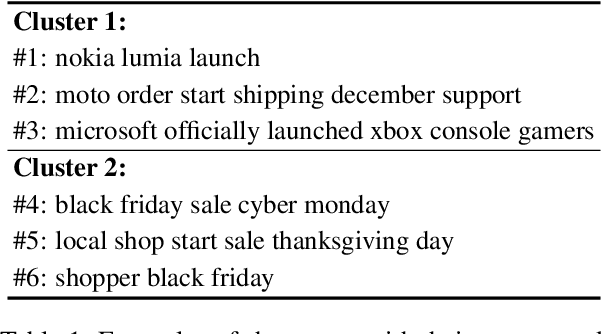
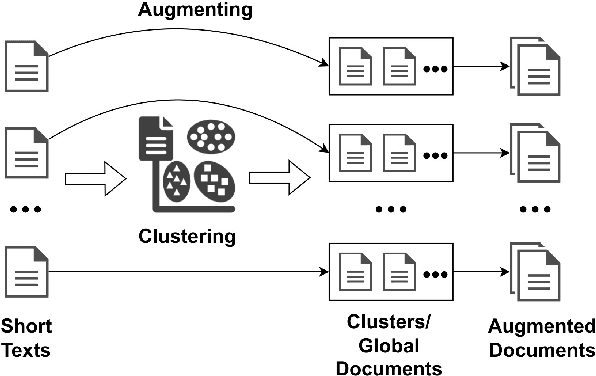
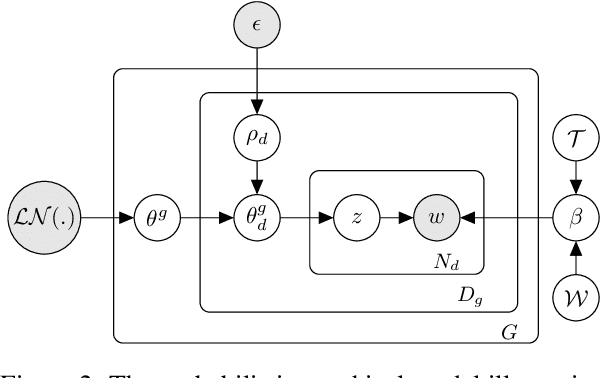
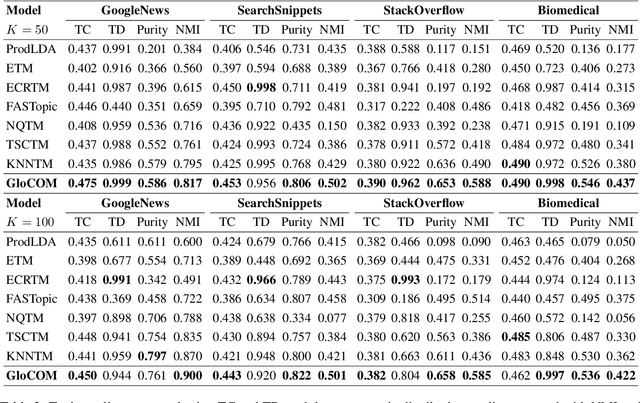
Abstract:Uncovering hidden topics from short texts is challenging for traditional and neural models due to data sparsity, which limits word co-occurrence patterns, and label sparsity, stemming from incomplete reconstruction targets. Although data aggregation offers a potential solution, existing neural topic models often overlook it due to time complexity, poor aggregation quality, and difficulty in inferring topic proportions for individual documents. In this paper, we propose a novel model, GloCOM (Global Clustering COntexts for Topic Models), which addresses these challenges by constructing aggregated global clustering contexts for short documents, leveraging text embeddings from pre-trained language models. GloCOM can infer both global topic distributions for clustering contexts and local distributions for individual short texts. Additionally, the model incorporates these global contexts to augment the reconstruction loss, effectively handling the label sparsity issue. Extensive experiments on short text datasets show that our approach outperforms other state-of-the-art models in both topic quality and document representations.
Lifelong Event Detection via Optimal Transport
Oct 11, 2024



Abstract:Continual Event Detection (CED) poses a formidable challenge due to the catastrophic forgetting phenomenon, where learning new tasks (with new coming event types) hampers performance on previous ones. In this paper, we introduce a novel approach, Lifelong Event Detection via Optimal Transport (LEDOT), that leverages optimal transport principles to align the optimization of our classification module with the intrinsic nature of each class, as defined by their pre-trained language modeling. Our method integrates replay sets, prototype latent representations, and an innovative Optimal Transport component. Extensive experiments on MAVEN and ACE datasets demonstrate LEDOT's superior performance, consistently outperforming state-of-the-art baselines. The results underscore LEDOT as a pioneering solution in continual event detection, offering a more effective and nuanced approach to addressing catastrophic forgetting in evolving environments.
NeuroMax: Enhancing Neural Topic Modeling via Maximizing Mutual Information and Group Topic Regularization
Sep 29, 2024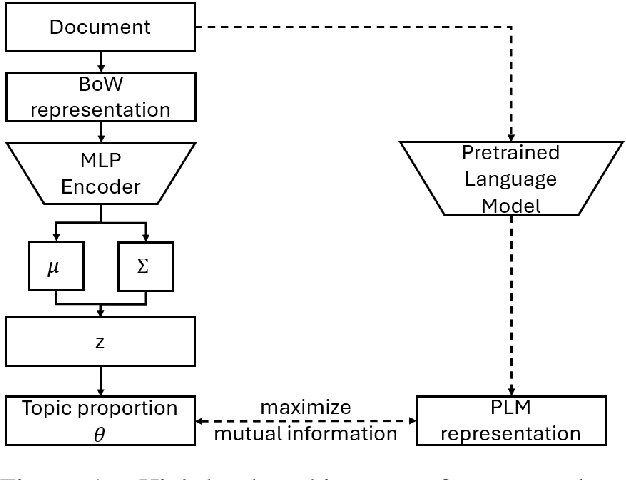
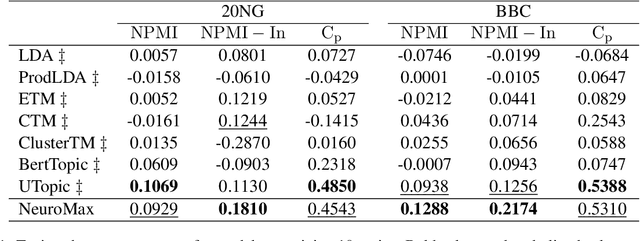
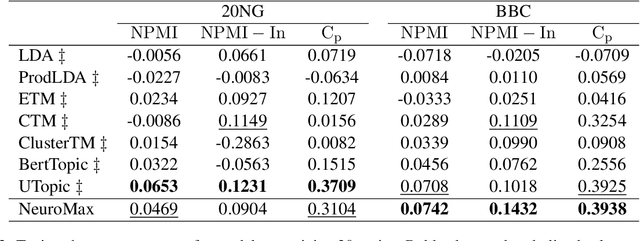
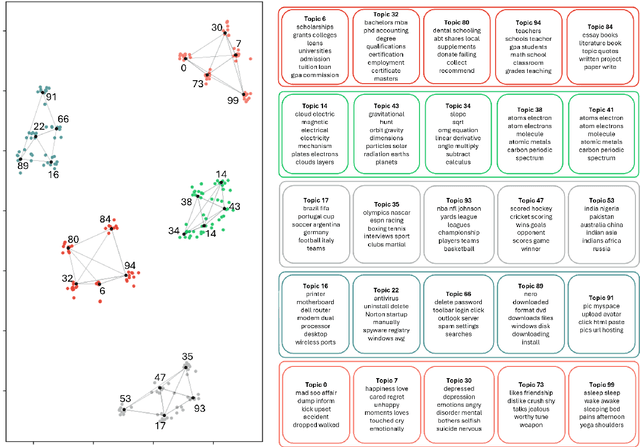
Abstract:Recent advances in neural topic models have concentrated on two primary directions: the integration of the inference network (encoder) with a pre-trained language model (PLM) and the modeling of the relationship between words and topics in the generative model (decoder). However, the use of large PLMs significantly increases inference costs, making them less practical for situations requiring low inference times. Furthermore, it is crucial to simultaneously model the relationships between topics and words as well as the interrelationships among topics themselves. In this work, we propose a novel framework called NeuroMax (Neural Topic Model with Maximizing Mutual Information with Pretrained Language Model and Group Topic Regularization) to address these challenges. NeuroMax maximizes the mutual information between the topic representation obtained from the encoder in neural topic models and the representation derived from the PLM. Additionally, NeuroMax employs optimal transport to learn the relationships between topics by analyzing how information is transported among them. Experimental results indicate that NeuroMax reduces inference time, generates more coherent topics and topic groups, and produces more representative document embeddings, thereby enhancing performance on downstream tasks.
ToVo: Toxicity Taxonomy via Voting
Jun 21, 2024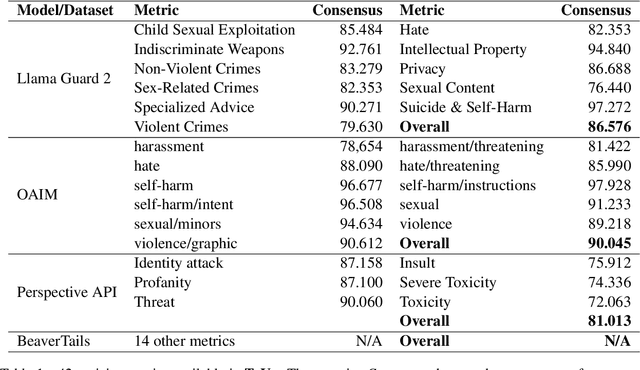
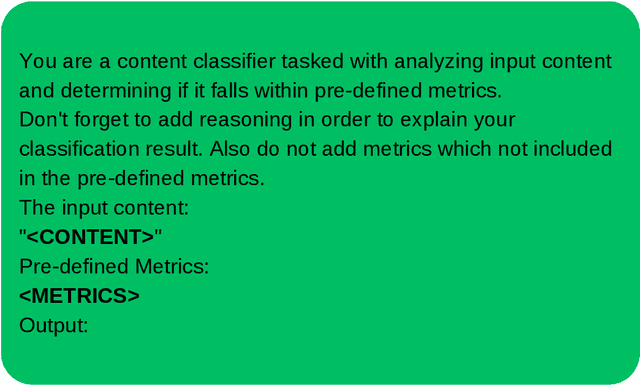

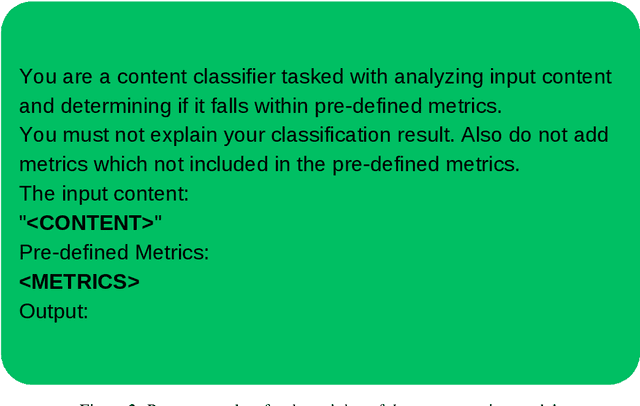
Abstract:Existing toxic detection models face significant limitations, such as lack of transparency, customization, and reproducibility. These challenges stem from the closed-source nature of their training data and the paucity of explanations for their evaluation mechanism. To address these issues, we propose a dataset creation mechanism that integrates voting and chain-of-thought processes, producing a high-quality open-source dataset for toxic content detection. Our methodology ensures diverse classification metrics for each sample and includes both classification scores and explanatory reasoning for the classifications. We utilize the dataset created through our proposed mechanism to train our model, which is then compared against existing widely-used detectors. Our approach not only enhances transparency and customizability but also facilitates better fine-tuning for specific use cases. This work contributes a robust framework for developing toxic content detection models, emphasizing openness and adaptability, thus paving the way for more effective and user-specific content moderation solutions.
Realistic Evaluation of Toxicity in Large Language Models
May 17, 2024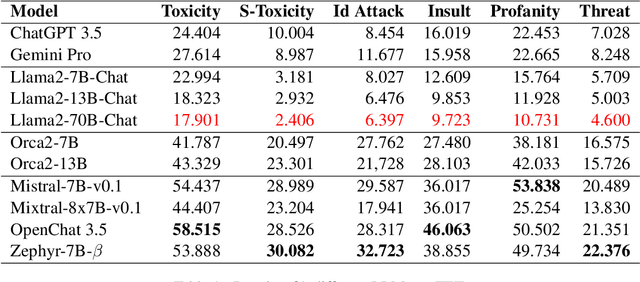



Abstract:Large language models (LLMs) have become integral to our professional workflows and daily lives. Nevertheless, these machine companions of ours have a critical flaw: the huge amount of data which endows them with vast and diverse knowledge, also exposes them to the inevitable toxicity and bias. While most LLMs incorporate defense mechanisms to prevent the generation of harmful content, these safeguards can be easily bypassed with minimal prompt engineering. In this paper, we introduce the new Thoroughly Engineered Toxicity (TET) dataset, comprising manually crafted prompts designed to nullify the protective layers of such models. Through extensive evaluations, we demonstrate the pivotal role of TET in providing a rigorous benchmark for evaluation of toxicity awareness in several popular LLMs: it highlights the toxicity in the LLMs that might remain hidden when using normal prompts, thus revealing subtler issues in their behavior.
 Add to Chrome
Add to Chrome Add to Firefox
Add to Firefox Add to Edge
Add to Edge